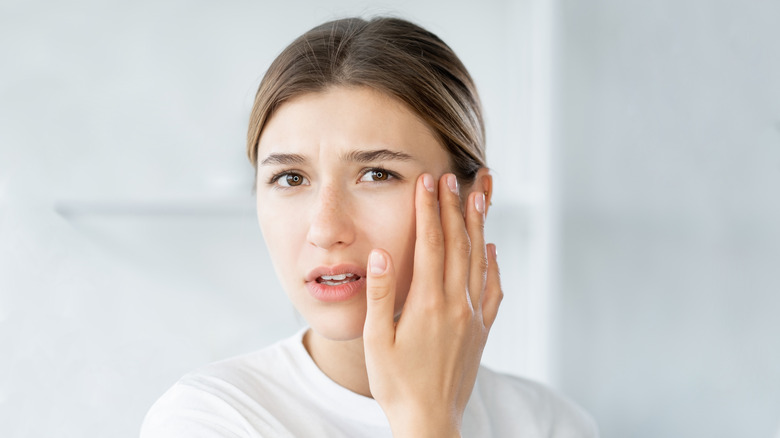Dry Vs. Dehydrated Skin: Yep, There's A Difference. Here's What To Know
If you notice that your skin is flaky, looks cakey under most foundation formulas, and is developing increasingly visible fine lines, you've probably diagnosed yourself as having dry skin. But the less well-known condition known as dehydrated skin actually boasts many of the same tell-tale signs as dry skin, so it's very easy to get confused between the two. It's important to know the difference, however, because a different approach is required depending on what affliction you're dealing with.
The most important thing to know is that dry skin lacks oil in its outer layer. Those who have a naturally dry skin type don't produce as much sebum as those who have oily or combination skin, per Esmi. This lack of oil leads to the skin not being able to maintain the moisture that it absorbs. Dehydrated skin, on the other hand, is skin that is lacking in water.
While both conditions can be uncomfortable, there are ways to deal with them. The first step in both cases begins with the correct identification.
Identifying and dealing with dry skin
Dry skin may be something you're born with, or it may come on as the result of external factors, including sun exposure and using harsh soaps (via Mayo Clinic). Most people with naturally dry skin will find that their skin gets worse in certain periods of the year, such as winter when the heating is frequently on, or when the weather is hot and dry.
Common signs of dry skin include flaking, peeling, the feeling of "tight" skin, fine lines, and skin that is rough to the touch. Incredibly dry skin can progress into conditions like eczema, which can involve a red, itchy, bumpy, skin surface.
If you have a dry skin type, you'll need to use special products in your skincare regime. Opt for nourishing formulas, such as creams and oils, over gels. Healthline recommends choosing products that are noncomedogenic to avoid blocking your pores. Steer clear of cleansers that strip away your skin's natural oils, and frequently use ultra-hydrating moisturizers, skin masks, and serums.
It's especially important to use SPF when you have naturally dry skin, as sun exposure will only make the problem worse. The sun's UV rays will also worsen the appearance of fine lines and wrinkles, which tend to be more obvious on dry skin anyway.
Note that if you do experience more serious dry skin conditions, like eczema, treatment options include steroid creams, the avoidance of triggering ingredients, antihistamines, breathable clothing, and medicated shampoos, per National Eczema Association.
How to treat dehydrated skin
Dehydrated skin can look a lot like dry skin. It similarly results in itchy skin with more prominent fine lines, however those who are dehydrated may also notice a dull, uneven complexion. Dehydrated skin may also come with more obvious signs like a dry mouth and light-headedness (via Dermatology and Mohs Surgery Institute).
Anyone can get dehydrated skin, no matter your skin type. This is another factor that can help you to determine which issue you're dealing with. You'll experience dehydrated skin when your body loses more water than it's taking in, most often because you're not drinking enough. It can also be caused by losing too many fluids through sweating or being physically sick. If your skin is normally oily but suddenly feels dry after you've been sick or have been neglecting your fluids, your skin is probably dehydrated rather than just dry.
The most powerful (and obvious!) way to treat dehydrated skin is by hydrating yourself again. Start by upping your fluid intake to at least eight glasses of water a day, per Healthline. This is especially important if you work out a lot; remember to continuously sip as you exercise. At the same time, aim to reduce your caffeine and alcohol consumption, as these have a dehydrating effect. In extreme cases, you may need an intravenous treatment from a health professional to return your hydration levels to normal.


